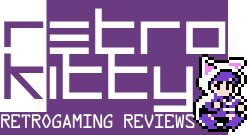Retrogaming Reviews — Latest · Alphabetical · Score · Articles · Site News · Random
Platforms — Arcade · Game Boy · Genesis · NES · PS1 · PSP · Saturn · SNES · TG-16
How Scoring Works
The rating system for games on RetroKitty is based on a six-point scoring system, each of which contributes to the overall rating from 1 to 10. The Overall Score is a weighted average of the six points, rather than a mean average, with some points weighted more heavily than others.
The six points used for rating the games are:
Graphics & Aesthetic — The graphics score is based upon the individual game’s graphical prowess compared to other games on the system, as obviously an Atari 2600 will never compete with a PlayStation. Aesthetic choice and overall style is timeless, however, and does affect this score.
Gameplay & Controls — How does it play, how do the controls feel, how overall fun is it? This point is a little more nebulous and subjective, but I try to remain as objective as I’m able to.
Sound & Music — How much does this game please the ears? Considering games as early as the third console generation have some incredibly memorable soundtracks, the music part of the score is based on how good the music sounds, regardless of the technical capabilities of the console.
Difficulty & Pacing — Is the game too easy, too hard, or just right? Is the pacing, direction and conveyance good, or is it a confusing mess with speedbumps of difficulty everywhere? High ratings in this score indicate a good difficulty curve and pacing, low scores can indicate a game that’s far too easy, too hard, inconsistent, or having major pacing issues.
Charm & Vibes — How does it feel? Even bad games can be charming in their own way, and even the worst games can have incredible vibes, with a well-defined and well-explored theme. This is another very subjective point in the scoring system, but I still do try to remain as objective as I can.
Reviewer’s Tilt — The most subjective of all the points in the score (and one of the lowest-weighted), the Tilt simply lets me freely apply my personal feelings and bias towards the game, in a way that’s fully subjective without actually affecting the overall score too heavily. After all, if you wanted a purely objective rating, you’d just look at aggregate averages.
The Numbers
The numbers on the score ratings are based on the modern review scale, sometimes known as the 7-10 scale. Personally I’m not the biggest fan, but I wanted to go with the most commonplace and well-understood review scores so that people get a good indication from a glance. To elaborate, the numbers represent:
- 10 – Perfect
- 9 – Excellent
- 8 – Good / Above Average
- 7 – Average / Okay
- 6 – Poor / Below Average
- 5 – Bad
- 2-4 – Varying levels of Extremely Bad
- 1 – Non-Existent / Absolutely Unplayable
